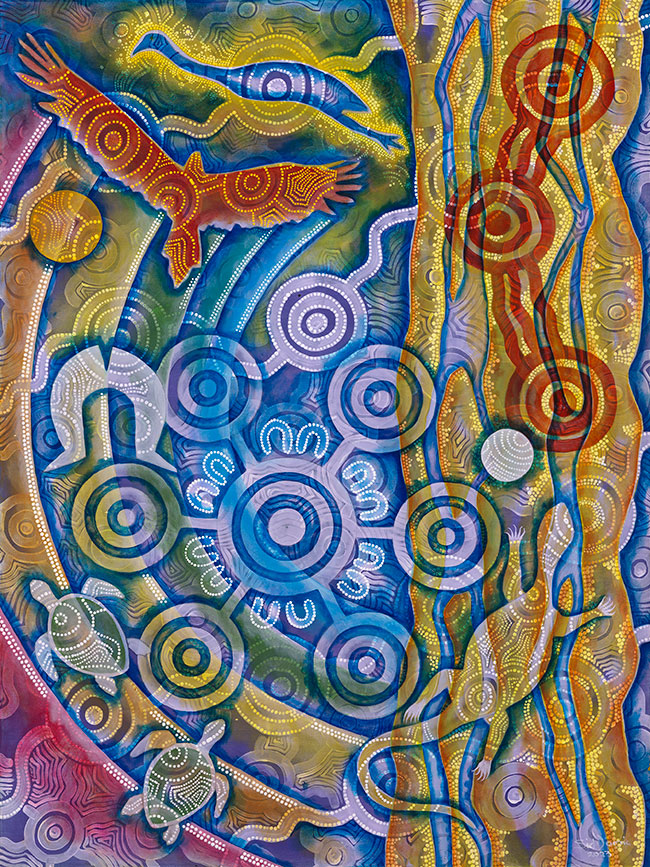Our mission is to become a leading Indigenous health research centre in Australia.
We exist to provide national and international leadership in Indigenous health research and research workforce development to improve life expectancy and transform health inequities and injustices in Australia and other international settings.
We will do this by creating impact through engaging in collaborative research that addresses gaps and challenges identified by Indigenous communities and building the capacity and capability of Indigenous health research communities in Australia.
Focusing on Indigenous ways of knowing, being and doing, we undertake multidisciplinary research to enhance understanding of diverse health issues affecting Indigenous peoples, reduce health inequity and improve health outcomes.
Strategic plan
The Poche Centre for Indigenous Health is dedicated to fostering a strengths-based approach in all our research and training endeavours, emphasising Aboriginal and Torres Strait Islander leadership, governance, capacity building, and unique ways of doing things.
Our strategic plan empowers researchers at UQ and beyond to develop and lead impactful research programs, aiming for excellence, translation, and impact. We prioritise initiatives that reduce health inequities and injustices and improve health outcomes nationally and internationally. We are committed to training and mentoring the next generation of Indigenous health research leaders, creating pathways for their success, and supporting non-Indigenous researchers in addressing our core strategies.
Read the UQ Poche Centre for Indigenous Health 2020–2024 Strategic Plan
Artwork
The Poche Centre’s visual identity is a reproduction of Consolidate by proud Kalkadoon artist Sid Domic. This artwork incorporates the concepts of his original ‘Potential’ piece, aligning with the centre’s evolving goals and partnerships. Visual identity holds significant importance for First Nations organisations, serving as a powerful representation of commitment and trust.
“Consolidate”
Sid Domic, 2023
Everything that has a spirit – whether it be grass, rocks, water – is living. If it’s living, it has a spirit; well, you can communicate with it. So that’s knowledge that has been pushed to the invisible. It doesn’t connect with Western ways. But if you can speak to the spirit of the lands, country, animals you can heal anything here in the present. We always can connect with the past and that knowledge for better cycles in the future when it comes to healing. Symbolising Aboriginal people through the Sand Goanna represents a connection to land, sea, water, forest, desert right across the country. The turtles and Torres Strait Islander Dhari represent Torres Strait Islander culture and their connection to the sea and maritime. You can see two of the oldest living cultures in the world and the knowledges that they possess in the areas of astronomy with the Milky Way, the emu in the sky, and the pattern of the bark of the tree representing ecological knowledges and knowledges for country and being able to access medicines, food for nutrition, also the ability to craft utensils, or weapons which we use in everyday life. The wedgetail eagle has a great story with regards to his perspective on life. From his perspective he sees 360 degrees. All that’s below him from that vantage point, he can see the past the present and the future unfold in front of him. These circles that spread across the painting represent different communities throughout Australia that the UQ Poche Centre is engaging with and collaborating with on research. The six circles around the outside represent research methodologies that will give an overview of the issue and look at pathways to healing in community.
can communicate with it. So that’s knowledge that has been pushed to the invisible. It doesn’t connect with Western ways. But if you can speak to the spirit of the lands, country, animals you can heal anything here in the present. We always can connect with the past and that knowledge for better cycles in the future when it comes to healing. Symbolising Aboriginal people through the Sand Goanna represents a connection to land, sea, water, forest, desert right across the country. The turtles and Torres Strait Islander Dhari represent Torres Strait Islander culture and their connection to the sea and maritime. You can see two of the oldest living cultures in the world and the knowledges that they possess in the areas of astronomy with the Milky Way, the emu in the sky, and the pattern of the bark of the tree representing ecological knowledges and knowledges for country and being able to access medicines, food for nutrition, also the ability to craft utensils, or weapons which we use in everyday life. The wedgetail eagle has a great story with regards to his perspective on life. From his perspective he sees 360 degrees. All that’s below him from that vantage point, he can see the past the present and the future unfold in front of him. These circles that spread across the painting represent different communities throughout Australia that the UQ Poche Centre is engaging with and collaborating with on research. The six circles around the outside represent research methodologies that will give an overview of the issue and look at pathways to healing in community.
“Potential”
Sid Domic, 2015
 The plant doesn’t reach its full potential until it flowers; a symbol of its expression and growth. In the image, the U shapes represent the UQ community (staff, students, Indigenous community, our partners). From the UQ community comes their individual growth, directed towards the centre circle, which represents a focal point of all this knowledge and energy. This creates the flower, which is symbolic of our potential as a community working together.
The plant doesn’t reach its full potential until it flowers; a symbol of its expression and growth. In the image, the U shapes represent the UQ community (staff, students, Indigenous community, our partners). From the UQ community comes their individual growth, directed towards the centre circle, which represents a focal point of all this knowledge and energy. This creates the flower, which is symbolic of our potential as a community working together.
